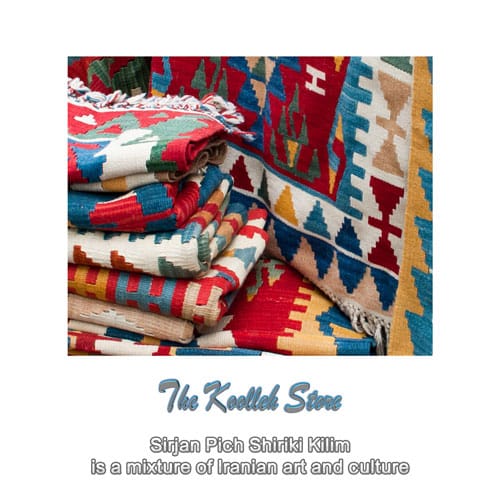Sirjan Pich Shiriki Kilim is a mixture of Iranian art and culture

It has a carpet-like shape from a distance, its design and pattern are not very uniform and it has enough variety. It is often dark, the pattern of the jaqeh bush with round flowers embedded in it is seen in many weaves, the designs of Goli Shool, Bush Shahi, Gol Musakhani and Qashqai flowers are among the most important motifs of this weave. It is one of the valuable handicrafts of Kerman province and is known as a needle kilim.
This patterned kilim, which is used to produce bags, paintings, chair covers and other things, was a part of the country’s non-oil exports in the past years and had its own customers in the markets of some countries, and the authorities tried to revive this art. , To introduce this product to the global markets once again .
The head of the carpet department of the Kerman Province Industry, Mining and Trade Organization says: Kerman province is one of the most experienced kilim weaving areas in Iran, which, apart from nomads and villagers, many urban women and girls are also engaged in this work.
Nasser Abbaspour adds: having ethnic diversity with different weaving cultures and the existence of local raw materials has always created a suitable platform for the growth and revival of this art in this province.
He adds: Shiriki Pich or needle kilim is one of the most significant handicrafts of the nomads and villagers of this province, which has a root of several hundred years in the weaving traditions of Kerman nomads, especially Afshar and Bachachchi.
Abbaspour continues: The high artistic and practical capacity of this kilim over the past few decades has led many producers to the main production hubs of this product (Sirjan and Baft regions), so that today the products of this region have a major share of domestic consumption and exports. Has been assigned to foreigners.
He says: The design and role of these handicrafts is a mixture of the original designs of Kerman nomadic kilim weaving and the designs taken from the traditions of Afshari weaving of Kerman carpet weaving, which has entered this art in the past few years due to the spread of carpet weaving. Is.
Abbaspour adds: The study of the products of this region shows that during the past years, along with the increase in demand, the traditional process of production of these handicrafts has undergone many changes, the most important of which is the diversity of designs and designs used.
He says: The screw weaving machine of Shiriki Pich kilims is almost the same as the weaving machine of the kilim that is placed horizontally on the ground. This machine is also composed of two parallel wooden beams that are about the width of the kilim and a little more apart. Another wooden beam is placed at the top and bottom of the device perpendicular to the two mentioned beams in parallel, so that the shape of the device is almost rectangular and the ends of the two beams around the top and bottom of the device go around.
Abbaspour says: In this type of kilim, unlike other types of weaving mats in which the weft causes the final formation of the product, the yarn and cream yarn play the main role and the weft only strengthens the engagement of the cream yarn with the yarn.
یسThe head of the carpet department of Kerman Province Industry, Mining and Trade Organization continues: Shiriki Pich is the name given to a type of kilim by nomadic and rural weavers of Kerman. The name Shiriki Pich is a partner of twisting two threads together and another quote is a partner of Kar It has come to make two or more weavers.
Abbaspour says: The designs of this kilim, due to their special facilities and weaving methods, sometimes go beyond the geometric state and become almost semicircular. Usually, there is symmetry in the designs, but in some cases, harmony and balance are obtained from asymmetrical designs. Two round flowers are seen among the twisted milky motifs and the role is important in terms of distance.
He says: Margins are often chains and consist of a repeated geometric shape that are placed between two parallel lines (embroidery), which are also called wheel borders, are more famous in text flowers (Kashmiri, Musa Khani, samovar, Heshmati, vase and tree). . This kilim is less seen with the middle bergamot and its other common designs are Qara, Laleh Abbasi, Kermani flower and a pair of flowers.
Considering that Sirjan city is the birthplace of Shiriki Pich kilim in Kerman province, the third national conference of Shiriki Pich kilim is scheduled in this city with the aim of developing, promoting, educating and introducing Shiriki Pich kilim , research and registration Presenting scientific and research materials about the design process, color and creation of this type of handicraft.
Ahadian, the secretary of the conference: This conference aims to identify and introduce the value and status of this traditional art and introduce the role of this type of handicraft in the life and beliefs of this region, pathology of designs, designs and quality. The texture of the kilim, how to introduce and identify the Shiriki Pich kilim at the international level (domestic and foreign markets), how to update the designs, designs and colors of the kilim with the tastes of today’s society, introducing the needs of manufacturers, suppliers and buyers.
He considers the study of the origin, evolution and evolution of designs and designs of Shiriki Pich kilim over time, the study of the geography of texture, role, design and color of Shiriki Pich kilim of Kerman province as the axes of the conference and says: the impact of values, customs and beliefs on The formation of different stages of design, role, color and texture of Shiriki Pich kilim in Kerman province is another important axis that will be discussed and discussed.

